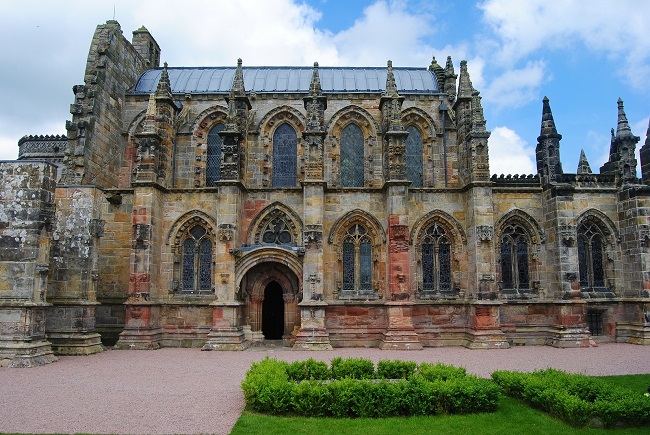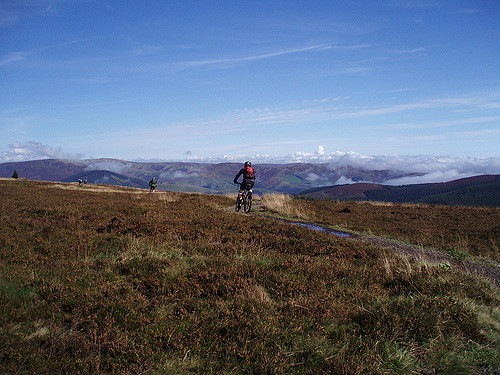This Scottish National Tourist Route is quite short – only 95 miles end to end – so it allows for plenty of interesting diversions. It follows one of the ancient routes from Edinburgh to the English Border, starting right in the middle of Scotland’s historic capital, on Princes Street. The road is better known these days as the A7; a very dull name but at least it’s easy to follow on signposts.
Edinburgh
Based just 10 minutes from Edinburgh Airport, we’re in the ideal location if you want to start your tour of Scotland with a trip to the beautiful capital. However, it’s better not to take a motorhome into the middle of Edinburgh as it can be a little difficult and frustrating to drive in. If you leave your campervan in one of the Park and Ride car parks and travel into the city by public transport, you’ll have a much more relaxing day and be able to see the sights at leisure.
You could easily spend a whole day walking along the Royal Mile from Edinburgh Castle to Holyrood Palace and the Scottish Parliament building. All three are worth visiting and there’s plenty more, including St Giles’ Cathedral, to see on the way. If you’re more interested in shopping, go to Princes Street and the New Town beyond. Whatever your tastes, you’ll find something to suit you in Edinburgh.
Heading out to start the tourist route, you need to leave the city by-pass at the Sheriffhall Junction, where it’s signposted to Carlisle. You could take your first diversion right here, by turning left onto the A6094 to Bonnyrigg and Roslin to visit the ornately-carved Rosslyn Chapel (made famous in the film The Da Vinci Code).

A little further down the A7 is Newtongrange. It was a mining village, and the Queen Victoria pit has been revived as the National Mining Museum. So if you’ve ever wanted to know what life down the pits was like, this is the place to find out.
Galashiels and the Border Abbeys
Between Newtongrange and Galashiels you may spot a steam train puffing along the newly-reopened Borders Railway. Mostly they run normal trains, which are popular with commuters and shoppers, but steam train excursions are a regular feature.
The A7 skirts round the borders of the town of Galashiels, and keeps you out of the town centre, so you get to see all the supermarkets and retail parks instead of the interesting historic buildings. Park in one of the retail parks and take a wander into the centre: it’s an elegant town with a long history and worth an hour or two of your time.
From Galashiels you can either follow the A7 or take a couple of very different detours. The first would be to head west along the north side of the River Tweed and try out the mountain bike routes at Glentress Forest, just before Peebles, and at Innerleithen. Glentress in particular is great for families, with different trail grades to cater for all abilities. And if you want to add to the group activities, there’s also a GoApe adventure set amongst the trees. If you haven’t got mountain bikes with you, don’t worry, you can hire bikes from Alpine Bikes at Glentress (and stop off at the cafe for some tasty treats and nibbles) as well as Innerleithen.

The other diversion is rather more cultural: it takes you to Abbotsford, the writer Sir Walter Scott’s extraordinary home, built in the Scottish Baronial style just outside Melrose. From there you can go on to Melrose itself, which has an ancient Abbey and a modern Peace Garden; the town itself is also worth seeing.
Further away from your route, but in the same direction as Melrose, are three other ruined abbeys, Dryburgh, Kelso and Jedburgh. The Scottish Borders are excellent farming country and the abbeys were large-scale landowners. Even as ruins, the size and beauty of the buildings shows how rich these communities became.
Selkirk
Your official route continues from Selkirk, a market town set high on a hill above the river (the Ettrick Water). You may find the zig-zag road through town a bit daunting, but 44-tonne trucks manage it! You might want to park up after manoeuvring around it, and the town is worth a visit anyway.
Every June Selkirk holds the Common Riding, when horse-men and -women ride round the boundaries of the town lands. This event dates back some 400 years. Originally it was performed to check that no-one was squatting on the land but now it’s more of a social occasion. It’s the one day of the year when taking a motorhome through the town is probably best avoided.
If you happen to be in the area that day, you can miss Selkirk by heading for Moffat on the A708 instead. It’s a pretty drive through the hills and past St Mary’s Loch and the Grey Mare’s Tail waterfall, which provides a good walk up a steep hill (you can walk anywhere in Scotland, provided you do no damage and leave gates as you found them). The Grey Mare’s Tail is National Trust for Scotland property and there’s an honesty-box in the car park at the bottom for non-members to pay for its upkeep.
Alternatively, just stay in a campsite near Selkirk and join in the fun!
Hawick and the south
If you stick to the A7, your next stop is Hawick, which is noted for its sheep and was another important market town. If you want to stretch your legs, the hills in this area are full of forts and ancient earthworks. Fights and cattle-thieving from both sides of the Border were fairly constant here until the 18th century.
From Hawick the road runs up and down the Teviot Hills to Langholm. It’s an exhilarating run with plenty of bends, some of them sharp, so take it gently. A stroll around the historic town will provide a welcome break before heading for Canonbie. The village has been bypassed since a landslide ruined the old road but it’s worth the short detour to visit it.
Shortly after Canonbie you cross the border into England and have two options: south to the historic town of Carlisle, which dates back to Roman times and boasts both a castle and a cathedral, or west on the A6071 to Gretna Green and its tourist shops. Or both – you’re on holiday!
Both Carlisle and Gretna are on the M6, which will take you happily back to Glasgow and Edinburgh. If you’re not ready to stop yet, Gretna marks the start of the Galloway Tourist Route, which will be covered in another blog.